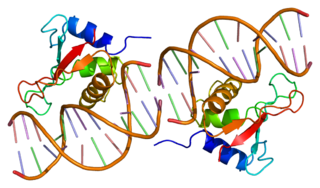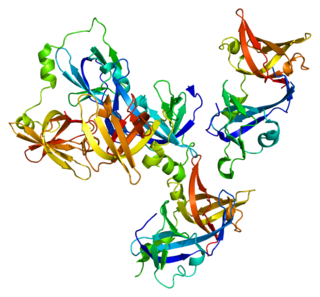
Interferons are a group of signaling proteins made and released by host cells in response to the presence of several viruses. In a typical scenario, a virus-infected cell will release interferons causing nearby cells to heighten their anti-viral defenses.

Endogenous retroviruses (ERVs) are endogenous viral elements in the genome that closely resemble and can be derived from retroviruses. They are abundant in the genomes of jawed vertebrates, and they comprise up to 5–8% of the human genome.

Signal transducer and activator of transcription 1 (STAT1) is a transcription factor which in humans is encoded by the STAT1 gene. It is a member of the STAT protein family.

Interferon regulatory factor 3, also known as IRF3, is an interferon regulatory factor.

Signal transducer and activator of transcription 2 is a protein that in humans is encoded by the STAT2 gene. It is a member of the STAT protein family. This protein is critical to the biological response of type I interferons (IFNs). STAT2 sequence identity between mouse and human is only 68%.

Interferon-alpha/beta receptor beta chain is a protein that in humans is encoded by the IFNAR2 gene.

Interferon regulatory factor 1 is a protein that in humans is encoded by the IRF1 gene.

Interferon alpha-2 is a protein that in humans is encoded by the IFNA2 gene.

Gamma-interferon-inducible protein Ifi-16 (Ifi-16) also known as interferon-inducible myeloid differentiation transcriptional activator is a protein that in humans is encoded by the IFI16 gene.

Interferon regulatory factor 9 is a protein that in humans is encoded by the IRF9 gene, previously known as ISGF3G.

Interferon-induced protein with tetratricopeptide repeats 1 is a protein that in humans is encoded by the IFIT1 gene.

Interferon alpha-inducible protein 27 is a protein that in humans is encoded by the IFI27 gene.

Interferon-induced protein with tetratricopeptide repeats 2 or IFIT2 is a protein found in humans which is encoded by the IFIT2 gene.

Myeloid cell Nuclear Differentiation Antigen is a protein that in humans is encoded as MNDA gene.

Interferon-induced transmembrane protein 1 is a protein that in humans is encoded by the IFITM1 gene. IFITM1 has also recently been designated CD225. This protein has several additional names: fragilis, IFI17 [interferon-induced protein 17], 9-27 [Interferon-inducible protein 9-27] and Leu13.

Interferon-induced 35 kDa protein is a protein that in humans is encoded by the IFI35 gene.

Interferon omega-1 is a protein that in humans is encoded by the IFNW1 gene.

Interferon-induced GTP-binding protein MX2/MXB is a protein that in humans is encoded by the MX2 gene.

Interferon-induced transmembrane protein 3 (IFITM3) is a protein that in humans is encoded by the IFITM3 gene. It plays a critical role in the immune system's defense against Swine Flu, where heightened levels of IFITM3 keep viral levels low, and the removal of IFITM3 allows the virus to multiply unchecked. This observation has been further advanced by a recent study from Paul Kellam's lab that shows that a single nucleotide polymorphism in the human IFITM3 gene purported to increase influenza susceptibility is overrepresented in people hospitalised with pandemic H1N1. The prevalence of this mutation is thought to be approximately 1/400 in European populations.

Interferon-induced transmembrane protein 2 is a protein that in humans is encoded by the IFITM2 gene. IFITM1 is a member of the IFITM family which is encoded by IFITM genes.



















